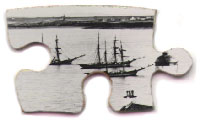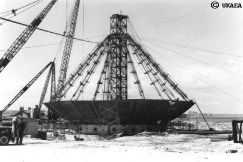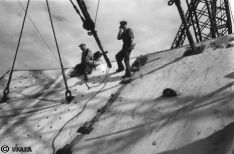



Highland Archives
Sponsored by ![]()
Dounreay 1954 - The Fears and The Facts
When Donald Carmichael, Works Secretary at The United Kingdom Atomic Energy Authority's Dounreay research establishment, closed his first correspondence file on 19th August, 1955 it was bulging with 371 letters, reports and memoranda on subjects ranging from complex land purchase and tenancy negotiations, to the provision of shoe repairs at a construction camp. It had been an interesting twelve months, far different to what Carmichael imagined it would be when he was given his original brief by Sir Christopher Hinton, chief of the UKAEA's Industrial Group. Then his title had been 'Liaison Officer'; his job - to smooth the administrative path for the pioneering Dounreay Fast Reactor Project.
 |
| The construction of the base |
 |
| Welding in progress |
Donald Carmichael first heard about the likely choice of Dounreay as the site of the experimental fast breeder reactor in June 1953, when he was interviewed by officers from Her Majesty's Security Service. Eight months later he was seconded from his post as a Principal with the Ministry of Works, to the Ministry of Supply's Atomic Energy section. He was not a total stranger to the atom; his brother Hugh was a prominent nuclear physicist and friend of Sir John Cockcroft, head of the Atomic Research Establishment at Harwell. Cockcroft was the scientist counterpart to Christopher Hinton, an engineer whose Risley based technical team had already built the extensive nuclear facilities at Windscale and Springfields, in the north-west of England. This team were now far down the road on the quest to squeeze cheaper energy from uranium atoms.
Until the early 1950's atomic energy research had been almost wholly military orientated, every gram of fissile material being commandeered for bomb production purposes. But the severe winter of 1947, when it was so cold that folk pulled carpets over their beds in an effort to keep warm at night, brought a forcible reminder of Britain's dependence on coal for its prime energy source. Atomic piles produced heat; it went to waste. Was it not possible to harness this waste energy, and put it to use raising steam for driving electricity generators? It was, and a nuclear power. station was being built at Calder Hall, next to Windscale. Calder Hall, however, was an Inefficient user of uranium, only 1% of this valuable fuel being utilised by the reactor. Another alternative existed, in theory, at least. This was the so-called breeder reactor which would not only use uranium more efficiently, but would also produce more fuel, in the form of plutonium. This breeding process had been proved on a small scale, but a reactor large enough to produce heat energy for electricity generation was an unknown quantity. It was also potentially dangerous. This potential danger had to be offset against the demands of British Industry, which was anticipating a production expansion based on a cheap, reliable supply of nuclear powered electricity. There was another important consideration - supplies of uranium ore were dwindling, and available material was almost sure to be requisitioned by the military. Caught up between the expectations of industry and military demands, with the added complication of uncertain uranium supplies, the atomic energy planners were willing to speculate that a remote risk was an acceptable risk.
Dounreay was chosen chiefly because of the assumed risk that, in the event of a catastrophic control system failure leading to core meltdown, a release of radioactivity to the environment was a likely consequence. This would result in the necessary evacuation of people living in the vicinity of the reactor, possibly within a radius of a few miles. The population density around Dounreay was very low, lower than that of West Cumbria. If it hadn't been, the fast reactor would have certainly gone to Windscale. To its credit, the UKAEA has never made any secret of its prime reason for coming to Caithness.
Assuredly, Donald Carmichael was early made aware of the risks associated with the fast reactor; a pragmatic man of the world, well acquainted with the wider facts of life, he accepted these risks and had faith in the great abilities of the engineers who had designed the reactor. Not so many of his fellow Caithnessians.
Post-war Caithness was far from being a backwater of civilisation. In 1939 the county had sent its young men and women off to serve in the armed forces all over the world; many of them returned with expanded cosmopolitan outlooks. At home, thousands of servicemen from every corner of the earth had passed through Thurso on their way to Scapa Flow; then there was the army of Irish workers who had built the wartime aerodromes, not to mention the camps filled-with prisoners of war, Dounreay itself had been home to hundreds of displaced Polish servicemen, waiting to see what the uncertain post-war future held for them. They whiled away time at the aerodrome accomodation camp, learning carpentry and other useful trades. Strangers in Caithness are only friends in waiting. An atomic power plant was something totally different. An undercurrent of concern and uncertainty clouded the happy news about the economic advantages of having a fast reactor at Dounreay. Understandably no one wanted to jeopardise the chances of unthought of prosperity, but there were genuine fears about the unknown dangers of nuclear power,particularly radioactivity. To further stir this uncertainty, in March 1954, in the very week that the Government announced the choice of Dounreay as its fast breeder reactor site, alarming news arrived from the other side of the world.
When the second American hydrogen bomb test blew the guts out of Bikini Atoll in the Pacific Ocean, even the bomb's designers were shocked by its explosive power, the equivalent of 14 million tons of TNT. But that was only part of it; the radioactivity released by the explosion had spread far beyond the original exclusion zone, inflicting radiation burns on the skin of fishermen caught in the fall-out, and contaminating fish to dangerous levels. President Eisenhower expressed his hope that the Russians - who had also tested a hydrogen bomb - would stop vacillating and join the US in urgent talks to curb the development of nuclear weapons. Two atom bombs had ended the Second World War; the hydrogen bomb looked set to end everything. In Caithness, more than a few people thought that a hydrogen bomb was about to be built on their own doorstep.
From the outset the authorities had sought to allay public fears about the fast reactor. Immediately after the Government's announcement about Dounreay, Sir David Robertson, the charismatic MP for Caithness and Sutherland had addressed a packed meeting in Thurso's Miller Calder Hall. Sir David's speech is a masterpiece of tub-thumping triumphalism, in which he stated, with some justification, that had he not been the area's MP the fast reactor project would never have come to Caithness. These far from modest claims were endorsed by his platform partners, Brigadier Keith Murray, Convener of Caithness County Council, and John Sinclair, Thurso's Provost. John Sinclair advised the audience to continue eating fish, which would not be affected by the small amount of radioactivity discharged to the sea from Dounreay. He had personally sought the opinion of an expert who had studied data from surveys of the marine environment around Windscale, Sir David Robertson also promised to ensure that full compensation would be paid to anyone whose property or activities were adversely affected by the fast reactor. Reassuring words from well-respected public figures who had done everything in their power to ensure that the fast reactor came to Caithness. But when someone asked whether, given his assurances as to the reactor's safety, Sir David would exchange his London house for a croft at Buldoo, the audience's nervous laughter betrayed a still lurking sense of apprehension.
Early in April 1954, the Scottish Trade Union Congress, meeting at Aberdeen, passed a motion calling for the outlawing of the hydrogen bomb in particular, and atomic weapons in general. One delegate warned that Dounreay would be a potential atom bomb; another asked what would happen if the reactor got out of control. A week later the Caithness Courier started a series of articles drawing its readers attention to an HMSO publication entitled Britain's Atomic Factories. This booklet contained information on the discharge of liquid radioactive effluent from Windscale, concluding that no concentrations of radioactive contamination had been detected so far, and in Dounreay's case, effluent would quickly disperse in the swift running waters of the Pentland Firth. The book also declared that while danger did exist, workers in the nuclear plants were better protected than in any other industry, a statement which, arguably, remains true today. Whether or not these learned articles had any pacific effect on local fears is uncertain. To any half-decent public relations officer, faith in a known and respected local person would have seemed a better bet.
When Donald Carmichael arrived in Caithness in the summer of 1954, his prime mission appears to have been the recruitment of suitable staff for the fast reactor project. For weeks he journeyed all over the North, interviewing, assessing, sounding out likely candidates, relying on the contacts he had made as wartime officer in charge of shore radio stations in the northern highlands. From Tongue to Golspie he scoured the country, driven by Rab Murray whose father had owned a lemonade factory in Shore Street, Thurso, until the early 1950s' when failure to keep pace with mechanised production methods had led to its closure. Rab was later to become one of the first two Dounreay transport drivers.
In August 1954, Donald Carmichael's priorities changed. He was formerly introduced to the Caithness public as the UKAEA's local man on the ground. His first duties involved the Dounreay Small Holdings, which were then part of a complicated tenancy arrangement between the Admiralty and the Ministry of Agriculture. The UKAEA seems not to have had a total grasp of agricultural land law and custom; worse: a heavy-handed official valuer had soured relations with the local crofters. So insensitive was this individual's handling of affairs that Isabella MacDonald, owner of Isauld farm, had complained to Sir David Robertson, who questioned the Treasury Minister, R.A. Butler, in the House of Commons. The next valuer to appear at Dounreay was William Robertson of Edinburgh, a man whose tact and professional abilities were well-known to Donald Carmichael. Those who had dealings with William Robertson remember him as a 'fair man'. Opinions on his predecessor are better left unrecorded.
Carmichael's next task was to pacify certain Thursonians who were raising objections to the UKAEA's proposed West Thurso housing scheme. He was then called upon to spy out a building suitable for conversion into a staff hostel, to furnish information on the standard of accomodation available in Thurso hotels, and to supply a list of householders who took in lodgers. Initially, Donald Carmichael had not thought beyond his one year-secondment period, but in September 1954, he was instructed by Sir Christopher Hinton to choose a house suitable for the UKAEA's Dounreay Administrative Officer. He had a new title; and he now realised that his stay in Caithness was to be permanent. After considering houses at 29 Davidson's Lane, Castlehill House, Swordly Mill, by Bettyhill, and 'The Shrubbery', in janet Street (a house he dearly wanted, but which the official valuer did not consider worth the asking price), Donald Carmichael finally settled for the Dorrery sporting estate still owned by his widow Margaret.
Then there were the meetings to arrange between the UKAEA's officials and all manner of local authorities and councils. There was accomodation to arrange, meals to book, transport to order. And always there were those thousand and one little things which contributed so much to the initial success of the Dounreay project. Nothing was too much trouble; from making sure that the Sheep Club's Dounreay grazing rights were respected, to assisting locals to complete complicated security questionaires. And all the while he was reassuring local folk that they had nothing to fear and everything to gain from the Dounreay atom plant.
Two of Donaid Carmichael's suggested measures stand out among the many that involved him during that first year: his Concessions Scheme designed to attract staff to Dounreay; and the lectures on atomic energy given by Sir Christopher Hinton. The Dounreay Concession Scheme was knitted together from a wide variety of Civil Service policies aimed at providing time and money compensation for staff working in remote areas. It remained a vital lever in staff recruitment policy for almost 30 years. The Hinton lectures were over within a day; but their affects were immediate and long lasting.
By the winter of 1954 it was clear that, despite the great progress made in overcoming the many minor obstacles in the path of the fast reactor project, considerable disquiet about the plant's safety still existed in Caithness. The endorsement of a respected local man who had forsaken a high-flying career in Edinburgh to return to his native soil, was not nearly enough for some people. When the plutonium production facilities had been built at Windscale, the people of West Cumbria had been given a plainspoken lecture on exactly what it was that was about to come amongst them. Surely, Caithnessians were entitled to the same. in November 1954, Donald Carmichael wrote to Christopher Hinton suggesting that he come to Caithness and tell the local people just what the fast reactor was all about.
On New Years Day, 1955, Mr Kennet of The Times and Mr Walker of the Daily Mail got off the train at Thurso station. They were hungry, no food being served on Scottish trains on January 1st, but thirsty they were not, nor totally sober. Whisky had been in good supply throughout the journey north. These top London journalists had come to report on Sir Christopher Hinton's lecture, which was to be given in Thurso Town Hall on Tuesday, 4th. The lecturer duly arrived on the 3rd with his wife, Lady Hinton. The following day found them in the Operations Room of the Dounreay aerodrome Control Tower. It was cold; green mildew covered the walls. A dozen local crofters were their companions. Soon the people of Buldoo and Dounreay would be neighbours of the UKAEA.
That same evening Hinton gave another talk on the fast reactor at a crowded Thurso Town Hall. Both these talks are remembered for the way in which a complex subject was explained in a manner that ordinary folk could understand. More importantly, Christopher Hinton made no pretence about the risks involved with this as yet unproven technology. There was indeed a remote chance of an accidental release of radioactivity leading to temporary inconvenience to those living in the vicinity of the plant, and this had been the main reason why the UKAEA had chosen Dounreay. But, it was emphasised, this risk was very slight. By adopting such a frank approach to the issue of safety, Christopher Hinton removed most of the anxiety felt by the Caithness public. There were still those who doubted - and whose doubt, continuing to this day, must be respected - but the vast majority now put fear behind them and looked forward to days of increased prosperity.
The Hinton lectures represent an epoch in the early history of Dounreay. From then on things flowed more smoothly towards the ultimate short-term objective, the realisation of which occurred at 10.52 a.m. on Saturday November 14th, 1959, when the first nuclear chain reaction started in the Dounreay Fast Reactor. Donald Carmichael was neither scientist nor engineer, nevertheless his contribution to this historic moment was not unimportant.
In compiling this article, and researching a forthcoming book on the history of Dounreay, I have read through many pages of documents written by Donald Carmichael to individuals long since consigned to the obscurity of dusty archives or, in so many cases, the grave. For the most part the style of these documents is that of an educated civil servant, with now and then a personal aside on, for example, the subject of fishing flys or the best place to eat a Caithness breakfast. But written words tell only part of the story. Curious as to the character of the man whose archive I was delving into, spoke to numerous people who remember him. Being by nature a born sceptic who grew cynical, I am prone to doubt overgrowing testimonies; yet in every instance, those interviewed said the same thing; "Donald Carmichael was a gentleman."
The above article was based largely on documents from the personal archive of Donald Carmichael, Dounreay's first permanent employee. I am grateful to Margaret Carmichael for giving me the opportunity of consulting her late husband's papers.
Steven Cashmore 1998
![]()
Information contained on this page may only be used for
personal use,any request for full or part publication must be
carried out through the Highland archive.
Send information for these archives to william@caithnessarchives.org.uk